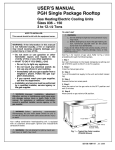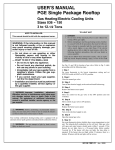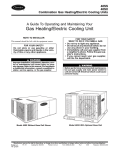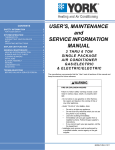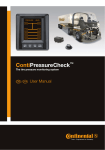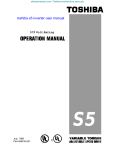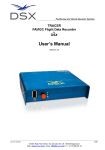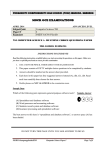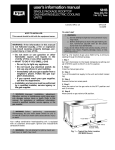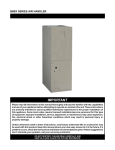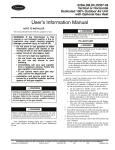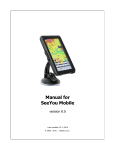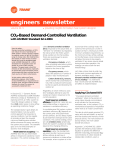Download USER`S MANUAL PGE Single Package Rooftop
Transcript
USER'S MANUAL PGE Single Package Rooftop Gas Heating/Electric Cooling Units Sizes 180 - 300 15 to 25 Tons2 NOTE TO INSTALLER This manual should be left with the equipment owner. TO LIGHT UNIT DANGER: 1. Do not turn off the electrical power to unit without first turning off the gas supply. 2. Before attempting to start the gas heating section, familiarize yourself with all the procedures that must be followed. WARNING: If the information in this manual is not followed exactly, a fire or explosion may result causing property damage, personal injury or loss of life. — Do not store or use gasoline or other flammable vapors and liquids in the vicinity of this or any other appliance. — WHAT TO DO IF YOU SMELL GAS • Do not try to light any appliance. • Do not touch any electrical switch; do not use any phone in your building. • Immediately call your gas supplier from a neighbor’s phone. Follow the gas supplier’s instructions. • If you cannot reach your gas supplier, call the fire department. — Installation and service must be performed by a qualified installer, service agency or the gas supplier. 3. Never attempt to manually light the pilot on unit with a match, lighter, or any other flame. If the electric sparking device fails to light the pilot, refer to the shutdown procedures, then call your dealer as soon as possible. If you do not follow these instructions exactly, a fire or explosion may result, causing property damage, injury, or loss of life. See Fig. 1 for location of gas valves. Refer to Fig. 2 while proceeding with the following steps. I. STEP 1 Set room thermostat to the lowest temperature setting and set SYSTEM switch to HEAT position. II. STEP 2 Close the external manual gas valve. III. STEP 3 Turn off the electrical supply to the unit. IV. STEP 4 WARNING: Improper installation, adjustment, alteration, service or maintenance can cause injury or property damage. Refer to this manual. For assistance or additional information consult a qualified installer, service agency, or the gas supplier. Remove the burner compartment access panel. WARNING: Before performing recommended maintenance, be sure main power switch to unit is turned off and lockout tag is installed. Electrical shock could cause personal injury. VI. STEP 6 Your combination heating/cooling unit is equipped with an automatic intermittent pilot and induced draft power combustion blower. WARNING: Pilot will light automatically. Do not attempt to light by hand; personal injury may result. V. STEP 5 Turn the control dial on the internal gas valve counterclockwise to the OFF position and wait 5 minutes. Turn control dial on internal gas valve clockwise position. VII. STEP 7 Replace the burner compartment access panel. VIII. STEP 8 Turn on the electrical supply to unit. IX. STEP 9 Open the external gas valve. 521 02 1201 01 Jan 2008 to ON INDUCED DRAFT MOTOR V. STEP 5 Turn the control dial on the internal gas valve counterclock- INTEGRATED GAS UNIT CONTROLLER (HIDDEN) wise to the OFF position. VI. STEP 6 Replace the burner compartment access panel. VII. STEP 7 If unit is being shut down because of a malfunction, call your dealer as soon as possible. If unit is being shut down because the heating season has ended, restore electrical power to the unit to ensure operation of the cooling system during the cooling season. Should overheating occur, or the gas supply fail to shut off, shut off the manual gas valve to the unit before shutting off the electrical supply. COMBUSTION FAN HOUSING MAIN BURNER SECTION FLUE BOX COVER Do not use this unit if any part has been under water. Immediately call a qualified service technician to inspect the unit and to replace any part of the control system and any gas control which has been under water. MAIN GAS VALVE Fig. 1 — Typical Gas Heating Section MAINTAINING YOUR UNIT X. STEP 10 Set room thermostat selector slightly above room temperature to start unit. The induced-draft combustion air fan will start. Main burners light within 30 seconds. Indoor blower will start within a few minutes of main gas ignition. XI. STEP 11 Set the temperature selector on room thermostat to desired setting. WARNING: If the pilot fails to light, the main burner fails to light, or the blower fails to come on, shut down gas heating section and call your dealer for service. Failure to follow these requirements could result in serious personal injury. All maintenance should be handled by skilled, experienced personnel. Your dealer can help you establish a standard procedure. For your safety, keep the area around the unit clear and free of combustible materials, gasoline, and other flammable liquids and vapors. To assure proper functioning of the unit, flow of combustion and ventilating air must not be obstructed from reaching the unit. Clearance of at least 4 ft on all sides is required. ROUTINE MAINTENANCE AND CARE FOR THE EQUIPMENT OWNER Before proceeding with those things you might want to maintain yourself, please carefully consider the following: WARNING: Do not turn off the electrical power to unit without first turning off the gas supply. WARNING: 1. TURN OFF GAS SUPPLY AND ELECTRICAL POWER TO YOUR UNIT BEFORE SERVICING OR PERFORMING MAINTENANCE. Failure to follow these procedures can result in serious fire or personal injury. 2. Do not turn off electrical power to this unit without first turning off the gas supply. See Fig. 1 for location of gas valve. Refer to Fig. 3 while proceeding with the following steps. 3. When removing access doors or performing maintenance functions inside your unit, be aware of sharp sheet metal parts and screws. Although special care has been taken to reduce sharp edges to a minimum, be extremely careful when handling parts or reaching into the unit. TO SHUT UNIT OFF I. STEP 1 Set room thermostat to lowest temperature setting and set SYSTEM switch to OFF position. II. STEP 2 Close the external manual gas valve. III. STEP 3 Turn off the electrical power supply to the unit. IV. STEP 4 Remove the burner compartment access panel. I. AIR FILTERS Air filters should be checked at least every 3 or 4 weeks and changed or cleaned whenever they become dirty. Table 1 indicates the correct filter size for your unit. Remove the filter access panel to replace or inspect the filters. All units have filter tracks into which the filters slide. Remove the filters by pulling outward from the track. See Fig. 4 for filter access panel location. Note the direction of flow arrows on the filter frame. —2 — STEP 2 STEP 3 STEP 1 STEP 4 STEP 5 STEP 7 STEP 6 STEP 8 STEP 9 STEP 10 Fig. 2 — To Light Unit —3 — STEP 2 STEP 1 STEP 3 STEP 4 STEP 5 STEP 6 STEP 7 Fig. 3 — To Shut Unit Off —4 — cleaned as necessary. Remove by removing screws in outdoor air filter retainer and sliding filters out of the unit. BURNER ACCESS PANEL (HIDDEN) HOOD (OPTION) WARNING: Never operate your unit without filters in place. Failure to heed this warning may result in damage to the blower motor and/or compressor. An accumulation of dust and lint on internal parts of your unit can cause loss of efficiency and in some cases, fire. Table 1 — Indoor-Air Filter Data* UNIT SIZE PGE OUTDOOR-AIR FILTER RETAINER 180-300† OUTDOOR-AIR FILTERS MOTORS AND FILTER ACCESS PANEL PGE180,210 TYPE OF FILTER Fiberglass Throwaway QUANTITY...SIZE (in.) 4...20 x 20 x 2 4...16 x 20 x 2 *When replacing filters, always use the same type and size originally supplied. †The PGE300 unit requires 2-in. industrial grade filters capable of handling face velocities of up to 625 ft/min (such as American Air Filter no. 5700 or equivalent). II. HEAT EXCHANGER HOOD (OPTION) OUTDOORAIR FILTER RETAINER To ensure dependable and efficient heating operation, the heat exchanger should be checked by a qualified maintenance person before each heating season, and cleaned when necessary. This checkout should not be attempted by anyone not having the required expertise and equipment to do the job properly. Checking and/or cleaning the heat exchanger involves removing the gas controls assembly and the flue collector box cover and, when completed, reinstalling the gas controls assembly for proper operation. Also, the flue collector box cover must be replaced correctly so that a proper seal is maintained. Contact your dealer for the required periodic maintenance. BURNER ACCESS PANEL (HIDDEN) MOTOR AND FILTER ACCESS PANEL OUTDOORAIR FILTERS PGE240 HOOD (OPTION) III. FANS AND BELTS Periodically check the condition of fan wheels and housings, and belt tension. When service is necessary, call your dealer. IV. EVAPORATOR-, CONDENSER-, AND COMBUSTION FAN MOTORS Lubrication is not recommended. Bearings will not require lubrication for at least 5 years of normal operation. After 5 years, motor life can be extended by having the motors serviced at an authorized motor service shop. BURNER ACCESS PANEL (HIDDEN) V. FAN SHAFT BEARINGS Lubrication is not recommended. When service is necessary, call your dealer. OUTDOORAIR FILTER RETAINER OUTDOORAIR FILTERS MOTOR AND FILTER ACCESS PANEL PGE300 Fig. 4 — Panel Locations For horizontal supply/return units, the size, location and number of air filters varies from Table 1. If you have difficulty in locating your air filter in the return-air duct system, or if you have questions concerning proper filter maintenance, contact your dealer for instructions. When replacing your unit filters, always use the same size and type of filter that was originally supplied by the installer. VI. EVAPORATOR AND CONDENSER COILS Cleaning of the coils should only be done by qualified service personnel. Contact your dealer for the required annual maintenance. VII. CONDENSATE DRAIN The drain pan and condensate drain line should be checked and cleaned at the same time the cooling coils are checked by your dealer. VIII. COMPRESSOR All compressors are factory shipped with a normal charge of the correct type refrigeration grade oil in them and should rarely require additional oil. The service technician must be certain the proper oil level is maintained in the compressor when it is installed and running. Units with outdoor air capability have a cleanable filter for the outdoor air. This filter should be checked annually and —5 — XIV. UNIT PANELS After performing any maintenance or service on the unit, be sure all panels are securely fastened in place to prevent rain from entering unit cabinet and to prevent disruption of the correct unit airflow pattern. IX. CONDENSER FAN WARNING: Do not poke sticks, screwdrivers, or any other object into revolving fan blades. Severe bodily injury may result. The fan must be kept free of all obstructions to ensure proper cooling. Contact your dealer for any required service. X. ELECTRICAL CONTROLS AND WIRING Electrical controls are difficult to check without proper instrumentation; therefore, if there are any discrepancies in the operating cycle, contact your dealer and request service. REGULAR DEALER MAINTENANCE In addition to the type of routine maintenance you might be willing to perform, your unit should be inspected regularly by a properly trained service technician. An inspection (preferably each year, but at least every other year) should include the following: 1. Inspection of all flue product passages — including the burners, combustion baffles, heat exchanger, flue collector box, and vent pipe. 2. Inspection of all combustion- and ventilation-air passages and openings. 3. Close inspection of all gas pipes leading to and inside your unit. 4. Inspection, and if required, cleaning of the condenser and evaporator coils. 5. Inspection, and if required, cleaning of the evaporator drain pan. 6. Inspection, cleaning, and lubrication of blower wheel housing and motor. 7. Inspection of all supply- and return-air ducts for leaks, obstructions, and insulation integrity. Any problems found should be resolved at this time. XI. INTEGRATED GAS CONTROLLER (IGC) The IGC board incorporates an LED that emits a flashing light to indicate an alarm code. If the furnace section will not operate and the LED is flashing a code (2 to 8 flashes in succession), contact your dealer and request service. See Fig. 1. XII. REFRIGERANT CIRCUIT The refrigerant circuit is difficult to check for leaks without the proper equipment; therefore, if inadequate cooling is suspected, contact your dealer for service. XIII. COMBUSTION AREA AND VENT SYSTEM The combustion area and vent system should be visually inspected before each heating season. The normal accumulation of dirt, soot, rust, and scale can result in loss of efficiency and improper performance if allowed to build up. CAUTION: If your unit makes an especially loud noise when the main burners are ignited, shut down the heating section and call your dealer. 8. Inspection of the unit base to ensure that no cracks, gaps, etc., exist which may cause a hazardous condition. 9. Inspection of the unit casing for signs of deterioration. See Fig. 1 and proceed as follows to inspect the combustion area and power-venting system of your unit. 10. Inspection of all electrical wiring and components to assure proper connection. 11. Inspection for leaks in the refrigerant circuit. Pressurecheck to determine appropriate refrigerant charge. 12. Operational check of the unit to determine working conditions. Repair or adjustment should be made at this time. 1. Turn off electrical power and gas supply to your unit. 2. Remove burner compartment access panel. 3. Using a flashlight, carefully inspect the burner areas for dirt, soot, rust, or scale. CAUTION: If dirt, soot, rust, or scale accumulations are found, call your dealer and do not operate your heating section. 4. When you have completed your inspection, follow the start-up procedures in this manual to restore your unit to operation. 5. Observe unit heating operation, and watch the burner flame with the access panel removed, to see if it is bright blue. If you observe a suspected malfunction, or that the burner flames are not bright blue, call your dealer. See Fig. 5. Some yellow flame may be present due to the panel being removed. 6. Replace burner compartment access panel. 13. Your servicing dealer may offer an economical service contract that covers seasonal inspections. Ask for further details. Complete Service Instructions can be found in the unit Installation, Start-Up and Service Instructions literature. BEFORE YOU CALL FOR SERVICE CHECK FOR SEVERAL EASILY SOLVED PROBLEMS If insufficient heating or cooling is suspected: ( ) Check for sufficient airflow. Check the air filter for dirt. Check for blocked return- or supply-air grilles. Be sure they are open and unobstructed. If these checks do not reveal the cause, call your servicing dealer. If your unit is not operating at all, check the following list for easy solutions: Fig. 5 — Proper Flame Appearance ( ) Check to be sure that your thermostat temperature selector is set above the indoor temperature during the heating season, or below the indoor temperature during the cooling season. Be sure the SYSTEM switch is in the proper HEAT or COOL position and not in the OFF position. ( ) Is the electrical supply switch ON? Are any fuses blown, or has the circuit breaker tripped? —6 — ( ) During the heating season, check the manual shutoff valve. Is this lever parallel with the pipe, indicating that the valve is open? Or is the lever at a right angle, indicating that the valve is closed? If closed, has the gas been shut off for safety reasons? Otherwise, you may open the valve and follow the start-up procedures listed in this manual. manual in the space provided.) If the dealer knows exactly which unit you have, he may be able to offer suggestions over the phone, or save valuable time through knowledgeable preparation for the service call. NOTE: Before proceeding with the next check, turn off the electrical power supply to the unit. Remove the control access door. ( ) During the heating season, check the control dial on the gas valve. Is it in the ON position? If it is not, be sure it has not been turned off for the purpose of safety. If nothing else seems to be amiss, follow the start-up procedures in this manual. If, after performing the above, unit performance is unsatisfactory, shut off the unit and call your dealer. ( ) If your unit still fails to operate, call your servicing dealer for troubleshooting and repairs. Specify the model and serial numbers of your unit. (Record them in this IN CASE OF TROUBLE Dealer’s Name _________________________________________ Telephone No. _________________________________________ Unit Model ____________________________________________ Unit Serial Number ____________________________________ —7 —








